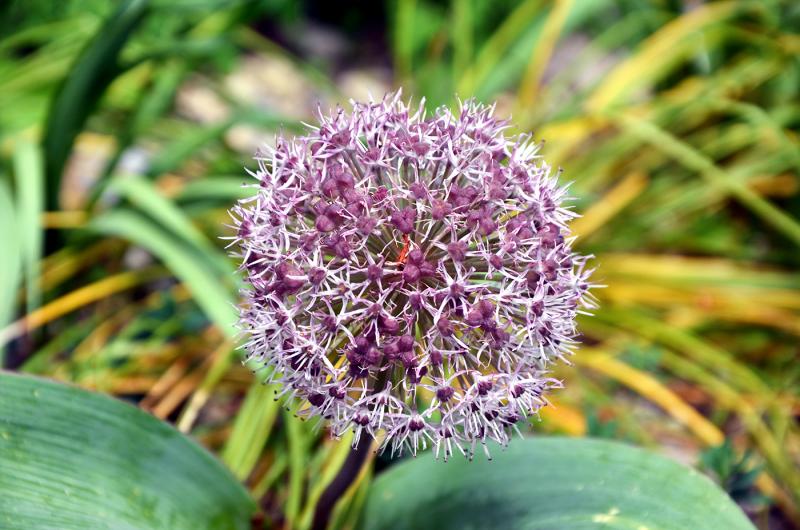Garden plants often come from remote corners of the world, and few places are more remote than Uzbekistan in Asia. Once an important stop on the Silk Road trade route from China, Uzbekistan is not only landlocked, that is, totally surrounded by land, but each of the countries surrounding Uzbekistan is also landlocked, making Uzbekistan along with Lichtenstein one of only two doubly landlocked countries in the world. And every country that surrounds Uzbekistan ends in -stan.
An amazing variety of an Uzbekistani ornamental onion is Allium karataviense Red Giant, which grows much larger leaves and flower heads than is typical for the species. It even blooms a bit earlier than the rest.
The globe-shaped blossoms are a deeper shade of purple than usual and grow in round heads from 5 inches up to 8 inches wide. The flower head is actually a cluster of tiny individual florets. The leaves stay a nice deep green while the plant blooms.
Red Giant is a low-growing plant reaching only 10-12 inches high. It not only looks great when planted in groups in the garden but also makes a surprisingly long-lasting cut flower. It blooms from late spring into early summer.
This show-stopping flower will attract bees, butterflies and hummingbirds, while keeping pests such as deer and rabbits away.
As you would expect from a plant native to Uzbekistan, Red Giant is hardy and can be grown in USDA Zones 3-8.
Plant Allium karataviense Red Giant bulbs in full sun in the fall. They need well-drained soil because wet soil will cause them to rot. Space the bulbs about 8-12-inches apart, or up to 2 feet apart if you want to mix in other perennials. Good companion perennials include astilbe, hosta, sedum, carnations and perennial geranium.
Set each bulb 6 inches deep. Because it only grows 6 to 12 inches tall, Red Giant allium is also good to plant in pots.
After your Red Giant alliums have finished blooming, you can cut and remove the dead flowerheads or leave them alone. If you do cut the spent flowers, you may get a second bloom. The dried seed heads themselves are quite attractive and make for a long-lasting ornamental feature to decorate your garden right up until early autumn.
Like all flowers that grow from bulbs, your Red Giant alliums need their leaves to produce energy for next year’s blooms, so let the foliage die back naturally. Once it has withered, it can usually be removed with a gentle tug. When herbaceous alliums have finished blooming, use scissors or hedge shears to trim off the spent flowers. This will keep the plants looking neat and may encourage a second flush of flowers.
For an interesting flower for next year's garden or vase, plant Red Giant Allium karataviense. It will remind you of faraway Uzbekistan and dreamy visions of the Silk Road.




















































